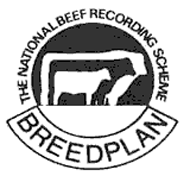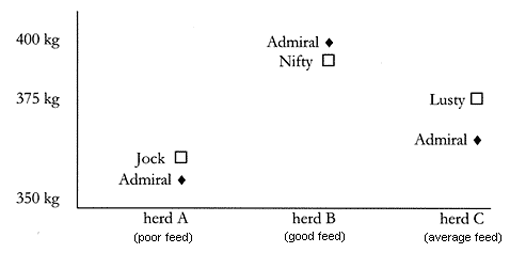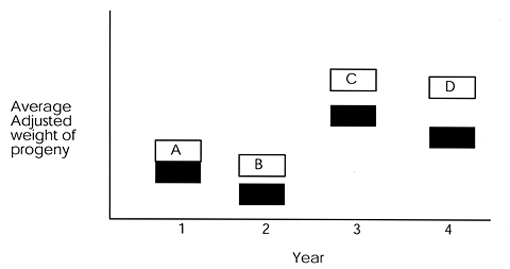
How BREEDPLAN compares cattle in different environments

Introduction
BREEDPLAN is a genetic evaluation program describing seedstock (particularly bulls) in terms of estimated breeding values (EBVs). EBVs are expressed in everyday units such as kilograms (kg) of weight, square centimetres (cm2) of eye muscle etc. They are calculated by taking these measurements in stud herds.
For accurate EBVs it is necessary to ensure that the differences recorded between animals are due to genetics, not environment. This is achieved by:
- initially only comparing like-treated cattle, that is, cattle in the same management group;
- then linking management groups via common genetics.
Management groups
Breeders note on their Performance Forms any individuals or mobs of cattle which have been treated differently — each of these is a different management group. BREEDPLAN comparisons are initially made within each of these groups, and then each group is compared with other groups containing linked genetics.
Link animals in various mobs
A link animal could be, for example, a sire on one property with progeny in three different mobs on that property, or an AI link sire with progeny in three herds on different properties.
Take a specific example where the progeny in herds on three properties A, B and C are compared. All three properties use a link sire by AI, and his progeny are compared with the progeny of a different home sire on each property. Property A provides poor nutrition, property C average nutrition, and property B very good nutrition.

When using the link sire (Admiral) as the basis for comparison, the progeny from Jock in herd A tested superior to the progeny from Nifty in herd B. The progeny from Lusty in herd C had the greatest advantage over the link sire progeny, and are therefore carrying the best genetics for 400 Day Weight. (In the graph, the vertical spacing between Lusty and Admiral is greater than that between Jock and Admiral.)
| Direct progeny comparisons | Indirect progeny comparisons |
|---|---|
| Jock vs Admiral = +5 kg | Jock vs Nifty (+5 kg + 5 kg) = +10 kg |
| Nifty vs Admiral = –5 kg | Jock vs Lusty (+5 kg – 10 kg) = –5 kg |
| Lusty vs Admiral = +10 kg | Nifty vs Lusty (–5 kg – 10 kg) = –15 kg |
The 400 Day Weight estimated breeding values (EBVs) for the three home sires and for the link sire are as follows. Admiral, the link sire, has been given the base zero EBV. These sire EBVs are twice the direct progeny comparisons listed above.
| 400 Day Weight EBVs |
Jock +10 kg |
Nifty –10 kg |
Lusty +20 kg |
Admiral 0 kg |
|---|
The above EBVs assume that reasonable numbers of progeny were measured and that the cows are of equal performance. Adjustments are made if cows are known to differ in their BREEDPLAN figures.
Of course, with the current wide use of AI, many such links occur between herds in most breeds. Most breed societies now use an integrated pedigree and performance system, which greatly facilitates the tracing of these links. This allows cattle in all the performance-recorded herds in the breed to be compared. These are then reported in BREEDPLAN, in national sire and dam summaries, on breed society websites, and in individual herd reports. These across-herd comparisons are now by far the most popular component of BREEDPLAN.
Genetic trends
As well as using link animals to compare across herds, we can also use them to compare across years. Hence, we can determine the genetic change over time, that is the genetic trend. The graph in Figure 2 shows the genetic trend by comparing a link sire’s progeny (represented by the black rectangles) with the progeny of four new home sires A, B, C, and D for each of four successive years.

Although the seasons have varied, we can see the rising genetic trend, as each year the new sires’ progeny are further ahead of the link sire’s progeny. (In the graph, the vertical spacing between the link sire’s progeny and the new home sire’s progeny progressively increases.)
Genetic trends are displayed in graph form in national sire summaries, and are tabulated in herd reports.
Environmental trends
In the example in Figure 2, we can see the average weights of the link sire’s progeny rising and falling with the seasons. BREEDPLAN herd reports tabulate this information as environmental trends. These show the effects of season, management, feeding technique etc. on progeny, free of genetic change.
Further information
See other Agnotes in this series for further information on BREEDPLAN and EBVs.
About the author
Brian Sundstrom is Cattle Breeding Coordinator with NSW Agriculture. Part of this role involves technical specialist and advisory work with BREEDPLAN from an office at the Agricultural Business Research Institute (ABRI) at Armidale. His other role is with the Beef CRC group.

